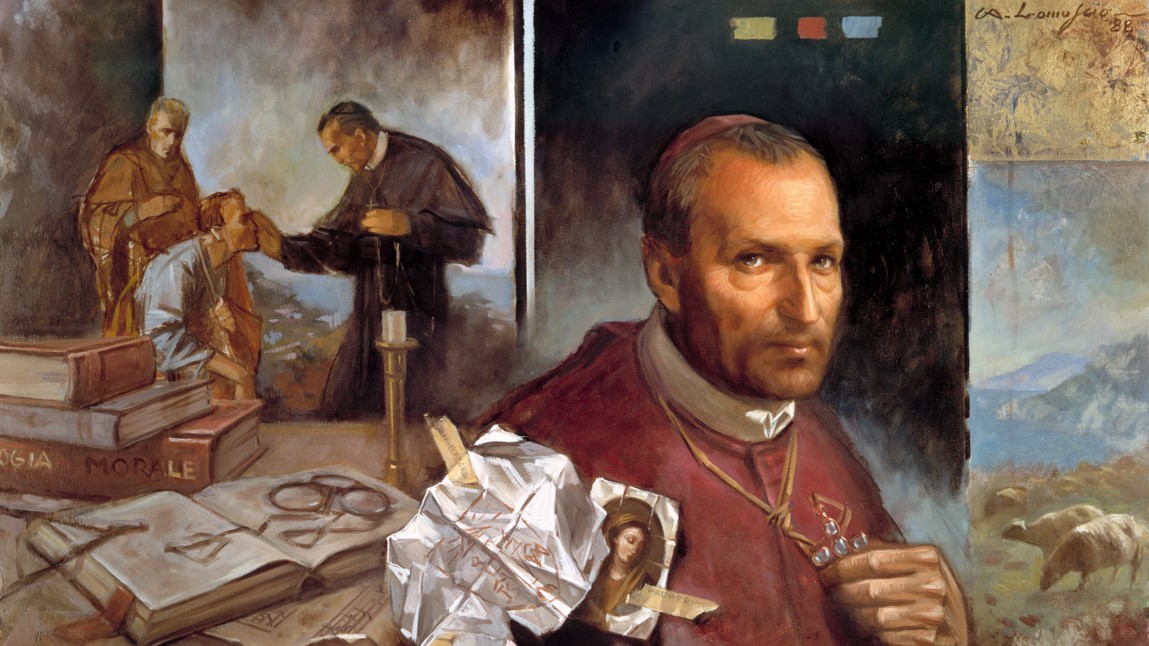

Deacon-structing Doctors of the Church, part 3
Deacon Pedro
Monday, April 19, 2021

S. Alfonso Maria de Liguori - "Evangelizare Pauperibus Misit Me" by Giuseppe Antonio Lomuscio, shared on Wikimedia Commons. Cropped and used under the terms of license CC BY-SA 4.0.
This week we will continue looking at some of the saints that the Church calls “doctors”. There are 36 doctors of the Church. We began two weeks ago by meeting the first six, and last week we met another six. Today we continue with saints who were named doctors in the 18th and 19th centuries.
Peter Chrysologus: He was the Bishop of Ravenna from 433 to 450. “Chrysologus” means “golden-worded”, and so he is known as the Doctor of Homilies. His short but inspired sermons are simple yet clear. Among his many sermons, he preached against heresies and about the Apostles Creed, the Incarnation, the Blessed Virgin Mary, and the Eucharist.
 Every week, Deacon Pedro takes a particular topic apart, not so much to explore or explain the subject to its fullness, but rather to provide insights that will deepen our understanding of the subject. And don’t worry, at the end of the day he always puts the pieces back together. There are no limits to deaconstructing: Write to him and ask any questions about the faith or Church teaching: [email protected]. Follow him on Facebook, Twitter and Instagram.
Every week, Deacon Pedro takes a particular topic apart, not so much to explore or explain the subject to its fullness, but rather to provide insights that will deepen our understanding of the subject. And don’t worry, at the end of the day he always puts the pieces back together. There are no limits to deaconstructing: Write to him and ask any questions about the faith or Church teaching: [email protected]. Follow him on Facebook, Twitter and Instagram.
"He is The Bread sown in the virgin, leavened in the Flesh, molded in His Passion, baked in the furnace of the Sepulchre, placed in the Churches, and set upon the Altars, which daily supplies Heavenly Food to the faithful." – St. Peter ChrysologusLeo the Great: Known as the “Doctor of the Church’s Unity”, Leo was pope from 440 to 461. He is the first pope to be called “Great”. Legend says that he convinced Attila the Hun against invading Italy. He is known for the Tome of Leo,which offered the foundation for the topics debated at the Council of Chalcedon (451), which dealt with the question of the dual natures of Christ. His Christmas Day sermon In Nativitate Domini deals with the question of the fundamental dignity of all Christians. He is remembered for strengthening the integrity of the faith and defending the unity of the Church.
"The Child, the Lord Jesus Christ . . . Word in our flesh, Wisdom in infancy, Power in weakness, and in true Man, the Lord of Majesty." – St. Leo IPeter Damian: He was a Benedictine monk, cardinal, and Bishop of Ostia from 1057 to 1073. As prior of the hermitage of Fonte Avellana, his renewal of religious life affected the whole of Italy. In his De divina omnipotentia, he deals with the doctrine of omnipotence, the idea that God can do nothing that is not good. Among his other writings, 67 treatises still survive, as well as many letters, sermons, and hymns. He also wrote The Lord Be With You, Life of Romuald, Officium Beate Virginis, De Institutione Monialis, and Disceptatio Synodalis, among others.
“Receive the Body and Blood of Christ very frequently. The sight of a Christian’s lips red with the Blood of Christ terrifies the enemy.” – St. Peter DamianBernard of Clairvaux: He was a French Cistercian monk who lived in the 12th century. He is referred to as the “Mellifluous Doctor” by Pope Pius XII in an encyclical dedicated to him because his teachings "were sweet as honey". This was a time of schisms, and Bernard travelled all over Europe restoring peace and unity. He wrote many theological and spiritual works, among them De Officiis Episcoporum, Grace and Free Will, On Loving God, and Steps of Humility and Pride.
“The road to hell is paved with good intentions.” – St. Bernard de ClairvauxHilary of Poitiers: He was Bishop of Poitiers, France, in the 4th century and is known as the “Doctor of the Divinity of Christ”. His vigorous fight against Arianism (he is sometimes known as “Hammer of the Arians”) resulted in a four-year exile by Constantine. He wrote many works in order to strengthen the faith and interpret Scripture, among them De Fide Orientalium, De Trinitate Libri XII, a commentary on the Gospel of Matthew, and expositions of the Psalms. He also wrote several historical works and hymns.
“No matter how sinful one may have been, if he has devotion to Mary, it is impossible that he be lost.” – St. Hilary of PoitiersAlphonsus Liguori: He was Bishop of Sant’Agata dei Goti and the founder of the Congregation of the Most Holy Redeemer (the Redemptorists), who lived in the 18th century. He was a renowned doctor in canon and civil law. He wrote many works on spirituality and theology but was also a composer and musician, artist and poet. His Moral Theology is a nine volume work. Other well-known writings are The Glories of Mary, Marian Devotion, The Way of the Cross, The Way of Salvation and of Perfection, The Holy Eucharist, and Truth of the Faith.
“So great is God's love for you that He seems to love no one but you. And therefore, you should love no one but Him.” – St. Alphonsus Maria de LiguoriI hope that by now, like me, you are beginning to be amazed at the vast body of works that have been written by these great saints and that form part of the Magisterium of the Catholic Church. Perhaps you are inspired to pick one of them up and read it? Come back next week and learn a bit about St. Francis de Sales, St. John Damascene, and St. Ephrem.
 Every week, Deacon Pedro takes a particular topic apart, not so much to explore or explain the subject to its fullness, but rather to provide insights that will deepen our understanding of the subject. And don’t worry, at the end of the day he always puts the pieces back together. There are no limits to deaconstructing: Write to him and ask any questions about the faith or Church teaching: [email protected]. Follow him on Facebook, Twitter and Instagram.
Every week, Deacon Pedro takes a particular topic apart, not so much to explore or explain the subject to its fullness, but rather to provide insights that will deepen our understanding of the subject. And don’t worry, at the end of the day he always puts the pieces back together. There are no limits to deaconstructing: Write to him and ask any questions about the faith or Church teaching: [email protected]. Follow him on Facebook, Twitter and Instagram.Related Articles:
<<













